

AMERICAN
WEREWOLF: THE TRUE STORY OF THE TORSO SERIAL KILLER CONFESSIONS
SELECT ADVANCE
PREVIEW EXCERPTS FROM A NEW BOOK BY PETER VRONSKY
Part 1(b): 2018-2019 - Searching for Severed
Heads and Who is "Torso Jane Doe"?
Copyright © 2024 Peter Vronsky All Rights Reserved
~ Uncorrected Ms. - Version 1.3 June 15, 2024 ~
“Aside from cutting off her head, though, I didn't really
mean to kill her."
~ Kevin Hearne Hunted: The Iron Druid Chronicles
THE SEARCH FOR THE SEVERED HEADS
When on December 2, 1979, FDNY responded to the report of a fire in
Room 417 in the Travel Inn on W. 42nd Street, the firefighters found two
female torsos with their heads and hands severed, laid out on separate beds
with the mattresses beneath them set on fire. Only a small few parts
of the two bodies were scorched by flames. The two victims
were covered in dozens of criss-crossing deep scratches, bordering on cuts,
over a hundred each. There were some bite marks, cigarette burns, and bruises from a
beating with strap or a stick or baton.
Victim ME-8105 was never identified. ME-8106
was identified as Deedeh Goodarzi.
The severed heads and hands, despite a search in the hotel and the neighborhood were never found, and at trial in 1984 in New York, Cottingham outright denied he had anything to do with the murders, until 2009 when he admitted to Canadian journalist Nadia Fezzani that he had previously known Deedeh Goodarzi and had indeed murdered the two women (the unidentified victim, a teenager around 17-years-old as estimated by the Medical Examiner.)
In the summer of 2018, Cottingham came around to describing to Jennifer and I where he buried the severed heads on the morning of December 2, 1979. My challenge was to pinpoint the precise location from his description and then how to get somebody at BCPO (Bergen County Prosecutor's Office) and/or NYPD to return my calls about these heads.
Cottingham said he buried the two heads in a vinyl valise, and as vinyl is non-biodegradable, we hoped that it perhaps had acted as preservative over the years. Regardless, the skulls would have been preserved and that afforded an opportunity for to reconstruct the facial features of the unidentified victim buried with Deedeh's head.
Identifying a victim's remains from 1979 if they could be found was a difficult challenge, but hardly an impossible task these days with advances in forensic sciences. It's been done before and for remains older than from 1979. In 2009, a "Jane Doe" found in Boulder, Colorado in 1954, was successfully identified through DNA by Mitotyping Technologies of State College, Pennsylvania, as Dorothy Gay Howard from Texas. Authorities believe she was the victim of serial killer Harvey Glatman "The Glamor Girl Killer" who was executed in 1959 in California's gas chamber. (See his case account in my book American Serial Killers)
"TORSO JANE DOE"
The victims' clothing had been found in Room 417 and
sized to the individual victims.
The teenage "Torso Jane Doe" was linked to a pair of BonJour
Paris designer blue jeans size 7/8, a red wool sweater size 38, a wool
black knee-length coat labeled “Original by Post Time” made in Poland, and black knee length glossy
leather boots, size C8, Charles Jourdan "Bostello" boots made in Italy.
The police located the importer of the boots, who stated that they imported
thirty pairs from Italy for the main Bloomingdale's store, on Third Avenue,
near the Queensboro Bridge and the "Girl Ghetto" of singles bars on the
Upper East Side. The boots had a letter “B” indelibly inked into their
shank, a piece of material between the outer and inner soles.
When police interviewed the buyer at Bloomingdale’s, they stated that they no longer stocked the boot for some time now and that the remaining stock was sold off to a jobber, Gabay’s on 225 First Avenue near E 13th St.
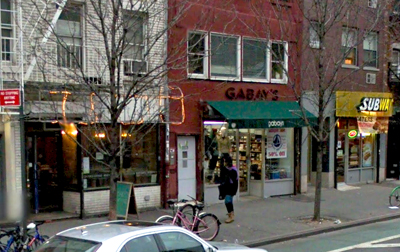
Gabay's circa. 2013
The owner Eddie Gabay stated that they routinely purchased left over boots from Bloomingdale’s and sold them out of their store. They mark the boot with a “B” he told police in order that people do not attempt to return the brand new boots to Bloomingdale’s for a full-price refund. And no, they could not help with tracing who bought the boots, they are a cash-and-carry business not set up to take consumer credit cards, police were told. According to a Federal Reserve study of credit cards, in 1979 only 63 percent of U.S. families, had any kind of credit cards, “including cards issued by banks, gasoline companies, retail stores and chains, travel and entertainment card companies (for example, American Express and Diners Club), and miscellaneous issuers (car rental and airline companies). (https://www.federalreserve.gov/pubs/bulletin/2000/0900lead.pdf )
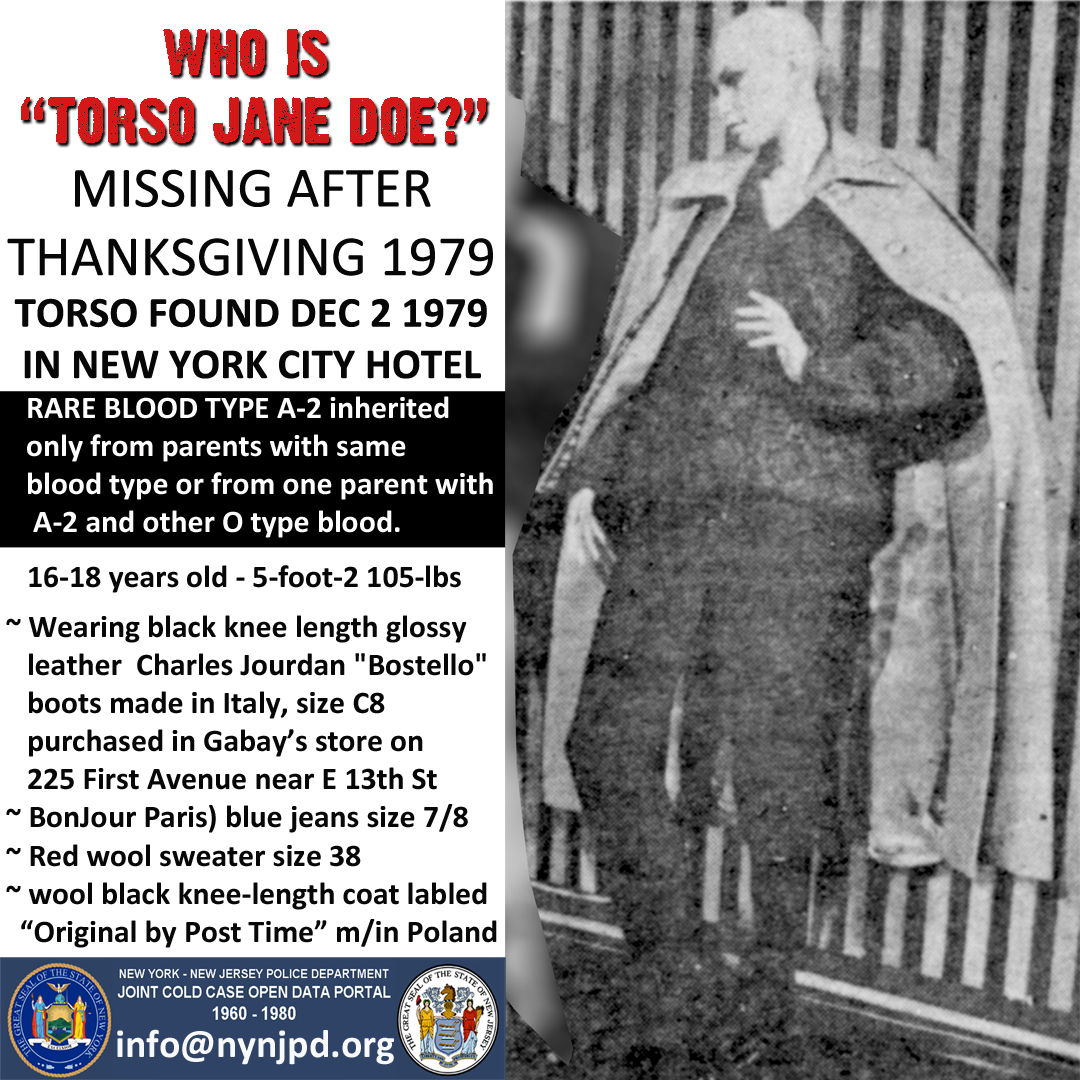
NYPD IMAGE 1979 OF "TORSO JANE DOE" CLOTHING
RARE BLOOD TYPE A2
With all the new innovations in DNA analysis and forensic
anthropological facial reconstruction, there is a possibility that the
teenage victim can still be identified if her facial remains could be located.
Moreover, "Torso Jane Doe" had a relatively rare A2 blood type,
which, regardless of DNA, could today aid in narrowing down a possible familial
lead to a DNA test and perhaps a family match. Only approximately
3%
of the population has A2 type blood.
In 1979-1980 the NYPD made a concerted effort to test parents who had reported their daughter's missing in the time period, to ascertain if there was an A2 blood type match; they never got one.

That was all we knew between 1979 and 2022, that "Torso Jane Doe" was a white female teenager, she had rare A2 type blood and bought a pair of boots in Gabay's discount store on 225 First Avenue near E. 14th Street. (The store was still there in August 2013 according to Google Maps historical view.)
Finding the heads was more integral to the reconstruction of the Jane Doe's face, than the DNA, because her torso is buried on Hart Island, and if the effort was made, her DNA could be sampled from it there. (Which is precisely what years later NYPD will plan to do, by "tapping" into the grave with a bore-drill but geologically the mass graves and markers shifted on Hart Island for an accurate tap trajectory, and a complete exhumation would be required, and the current budget does not allow for this to be undertaken nor is there the political will to undertake this.)
COTTINGHAM'S STORY
Cottingham disputed my belief that he 'bumped' me in the leg with a bag containing the
two
severed heads when I encountered him in the elevator doors of the Travel Inn
as he was fleeing the scene at around 8:50 am on Sunday, December 2, 1979.
Cottingham told Nadia Fezzani in 2009, and reiterated the same to me in 2018, that he had taken the severed heads out of Room 417 in the middle of the night in the valise and walked to where he parked his car and put them in the trunk. I had it wrong he said, that was not him on the elevator at 8:50 a.m. because he had left the hotel hours earlier.
But I saw him! At about 8:50 a.m. Was I mistaken?
Cottingham also told Fezzani in 2009 that as he was walking on 42nd Street to his car with the bag of heads, two NYPD officers in a patrol car called him over, asking him what was he doing out in the street so late at night, and that he remained calm, kept his composure and told them he was on his way to catch an early train, and they did not look into the valise he was carrying and let him continue on his way.
Considering the hue and cry raised ten hours later in that precinct about a white male suspect and two missing heads, I found it strange that nowhere in the NYPD case files is there a report from two cops about stopping a white male with a valise earlier that morning on 42nd Street in the vicinity of the hotel where two heads were missing.
I also found it hard to believe that cops, even on a slow
Sunday night, would pay any attention to anybody
walking on 42nd Street, even at 3:00 am, especially if they were a white
male, and take the trouble on a December night to roll down their
window, take time from their coffee and donuts or sleep, and engage a passerby
so randomly walking down a sidewalk. (And having gone through the trouble to
go that far then not take an extra thirty seconds and ask the guy to
show them what is in the bag he is carrying. Burglar tools maybe? A
commercial loft or store burglar?
I wondered if
Cottingham perhaps told Nadia that story to impress her how cool he was
under pressure when stopped by police. And now in 2018, nine years
later, he was locked into that story, repeating to me.
Nor in the three or four times that he repeated the narrative of the torso murderers to us, was he consistent on where he had parked his car. His memory is fragmented and often if he cannot remember something for sure, he substitutes with what he assumes he would have done. The first time I asked him where he parked his car, he said near his girlfriend's apartment, but that was way down on E 28th Street and Second Avenue. That is a long walk from W. 42nd and Tenth Avenue with 20lbs bag of heads. Each head would have weighed an average of 10-11 lbs. Plus the hands. And maybe the handcuffs too. It was like carrying a valise with two 10 lbs bags of flour or sugar in it.
Then on subsequent tellings, he
said he likely parked his car where he parked daily it to go to work, a garage on
42nd Street near by.
Cottingham said he put the heads into the trunk of his car, then drove the
car closer the Travel Inn, parked it there, and returned to his room,
cleaned up and packed up any other evidence he might have left behind (the
police found absolutely nothing, not a single useable fingerprint that could
be matched to him, nothing left behind, except for one small hemming pin
found on the bedside table between the two beds - the kind of pin
with a tiny plastic colored bead-ball on the end of it. The NYPD detective
on the scene would write in his report, “The only physical evidence I
noticed at the scene was a small yellow pin, such as a person would put on a
hem to hold the hem up.”
Later Cottingham would explain how the pin was integral
to a "torture game" he played with the victims.
The only thing Cottingham left behind other than the pin, was the women's
clothing and shoes, piled into the bathtub. A mistake he will regret because that is how Deedeh will be partly
identified - through her Philippe Marco shoes. They were sold in only
in a few Bamberger stores in New Jersey, and that narrowed down the search
for one of the bodies to a few locations, including Trenton.
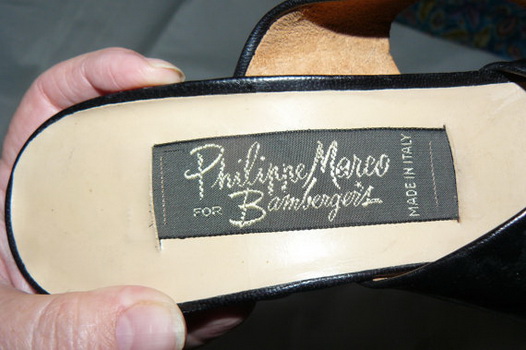
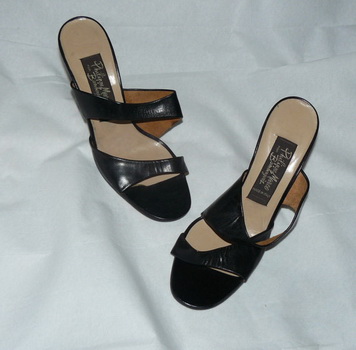
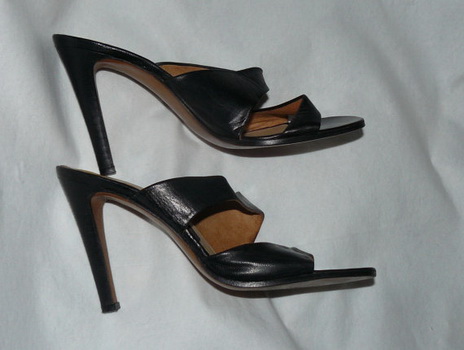
Deedeh's caesarean birth scar giving life to Jennifer 18 months before
her murder, narrowed it down further to Trenton, to hospital records there,
and a name.
Finally to confirm everything, a sex worker and her pimp who 'managed'
Deedeh, came in to report her missing and identified the torso by the distinct long toes and birth
marks Deedeh had.
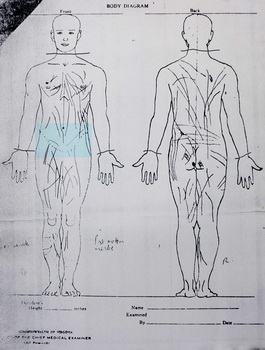
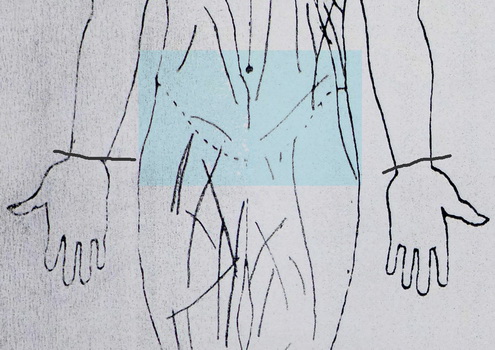
The Caesarean-birth scar that led to the
identification of Deedeh Goodarzi
(They were not actually "torsos" in the traditional sense of the word, as they both had all four limbs, except for the severed hands. They were "headless bodies" rather than torsos. But the press dubbed an "torsos" and that's how I remain referring to them and to Cottingham's moniker, the "Torso Killer.")
Once Cottingham packed up his remaining things and had everything ready to go, he then set the two mattresses on fire underneath the torsos. He set two separate fires on the mattress under Deedeh nearest to the door, one on the side and one on the end of the mattress, and one fire under "Torso Jane Doe" on the bed near the window. He used lighter fluid to initiate the flame but he said it was hard to keep it going, because perhaps the hotel linen was treated with fire retardants.
He did not set fire to the torsos themselves. Only small parts of the bodies near the mattress flames were scorched, one of Deedeh's foot and her calf were burnt almost down to the bone.
Once he got the fire going, he fled the
room, but at around 5:30 a.m., Cottingham insisted! How could I have seen him at
8:50
a.m.?
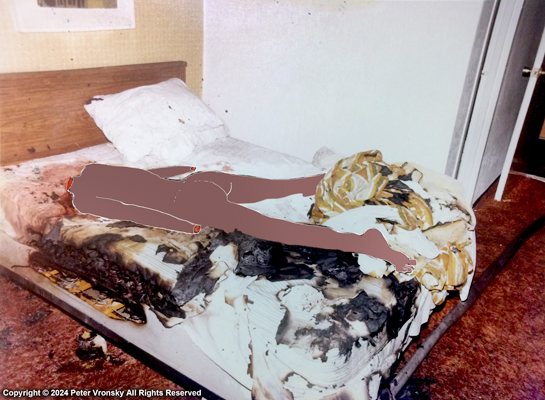
Cottingham said he set the fire in order that the fire department go into the room and hose it out, destroying evidence he might have overlooked. Which is exactly what happened.
The first problem, (other than my personally seeing Cottingham at 8:50 am) was that the fire department was called at about 9:00 am arriving at the scene at . How could three separate fires be burning from 5:30 a.m. to 9:00 a.m. without anybody reporting the smell or smoke?
Cottingham stated that he drove away from the hotel with the heads in the trunk of his car toward his home on Vreeland Street in Lodi, New Jersey, because he wanted to get home that Sunday morning before sunrise so the neighbors do not see he was out all night. He was a family man keeping up appearances. Cottingham stated that he would always come home to his wife before sunrise and see his three kids for breakfast and the two older ones, the boys, off to school before going to sleep, or he would not return at all if he missed sunrise. His daughter, the youngest of the three, had not started school yet.
Sunrise on December 2, 1979 in New York City was 7:02 am.
THE BURIAL LOCATION
From Cottingham's description of the morning after the murders, I deduced
that they were by the Hudson River shoreline just south of the George Washington
Bridge - under it - at the bottom of the cliffs in the Palisades Interstate
Park in New Jersey.
The location was on the route from New York to his home in Lodi and he would have to been familiar with it. It is not easy to find if you had not been there before.
There are two entries into the Palisades Park road system, 2.5 miles apart, and both are relatively "hidden" away, off smaller streets, one in Fort Lee near the George Washington Bridge, the other further north along Route 9W in Englewood. The road winding down to the river bank and under the bridge is steep and circuitous, with switchbacks, and round-about intersection. The roads are not lit at night. One has to be be very familiar with the way down - it's at least a ten to fifteen minute drive down.
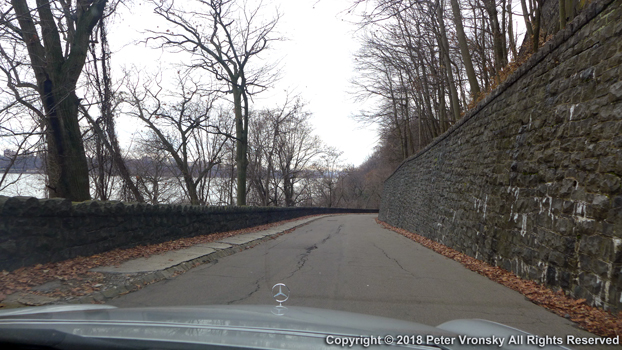
Cottingham said when he arrived there it was still dark. There was a narrow road - a "tow path" along the shore of the river under the bridge which came to a dead end at a small river inlet about 500 yards south of the bridge. Today it is blocked off by a boulder barricade to vehicle traffic south of the bridge, and is an overgrown walking trail. The boulder's have hooks in them, in order that they can be moved to allow the Palisades Park Service do drive utility vehicles down the trail. In 1979, however, it was a single lane dirt road open to all vehicles.
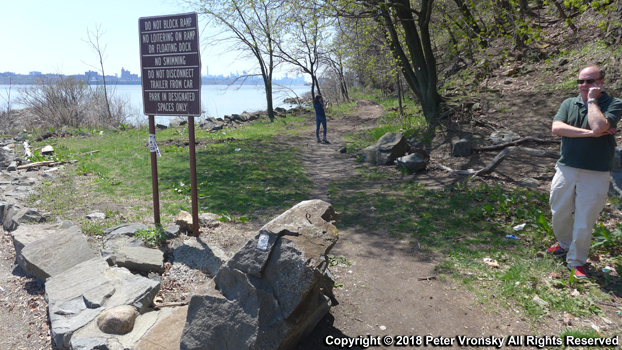

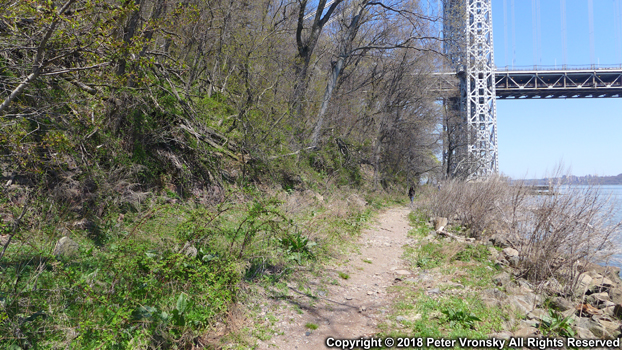
Cottingham described the distance where he stopped from the bridge in terms of a 'city block.' "About a block past the bridge", he said. I assumed he meant a New York City block, but was that like a cross-town east-west block, which are longer, or avenue north-south block, which are shorter? Cottingham when leaving bodies behind ("dropping them off" as he would say) always made sure that he could see any vehicles approaching from a long distance away. (See Part 9: The Curse of the McGraws: The 1970 Cold Case Murder of Lorraine McGraw.)
Because it was a dead end road, any vehicle would be coming from one direction only, from the north.
Cottingham said he pulled off "to the side of the road" not to block it.
BBecause the Palisades cliff ran right up against the road, except for one small part of the road where there was a small "pasture" on which a car could be parked off to the side of the road, I was able to pinpoint the only location where Cottingham could have parked his car that morning.
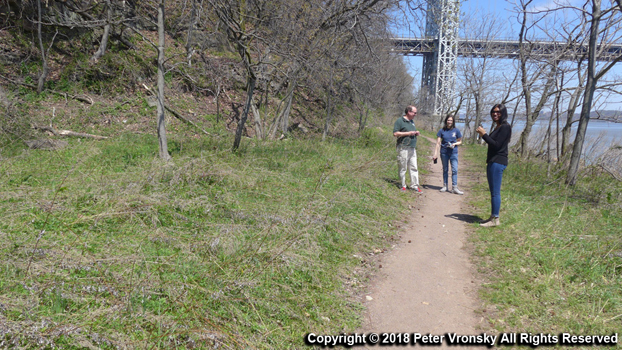
The "pasture."
Cottingham owned three cars in December of 1979, and all
three were huge big-ass cars popular in the 1970s. This was the only
spot that could accommodate any sized car, let alone the three vehicles
Cottingham was driving 1972-1980. (He did not remember which car he used on the
weekend of the torso murders.)
Cottingham vehicles impounded by BCPO in May
1980 after his arrest. The vehicle in the first photograph is parked at the
Quality Inn on Route 17 in Hasbrouck Heights where he was arrested on May
22, 1980 "red handed" torturing in his room a victim he had abducted from
Manhattan.
Cottingham described stepping out on a little beach at water level near where he parked his car off to the side of the road.
He wrote that he wanted to put the heads on a piece of wood and float them on the Hudson River so that they go out into the Atlantic Ocean, like a burial at sea. He wrote, "I thought that was something nice that she [Deedeh] would have appreciated."
Today as in 1979, the river shoreline is lined with huge stones, like a breakwater. They were installed there in the 1920s and 1930s. There is only one spot where somebody could come off the path and step down onto a tiny beach at water level jutting out into the river, the people sometimes let their dogs splash in the river on. Locals sometimes refer to it as "Dakota Dog Beach."
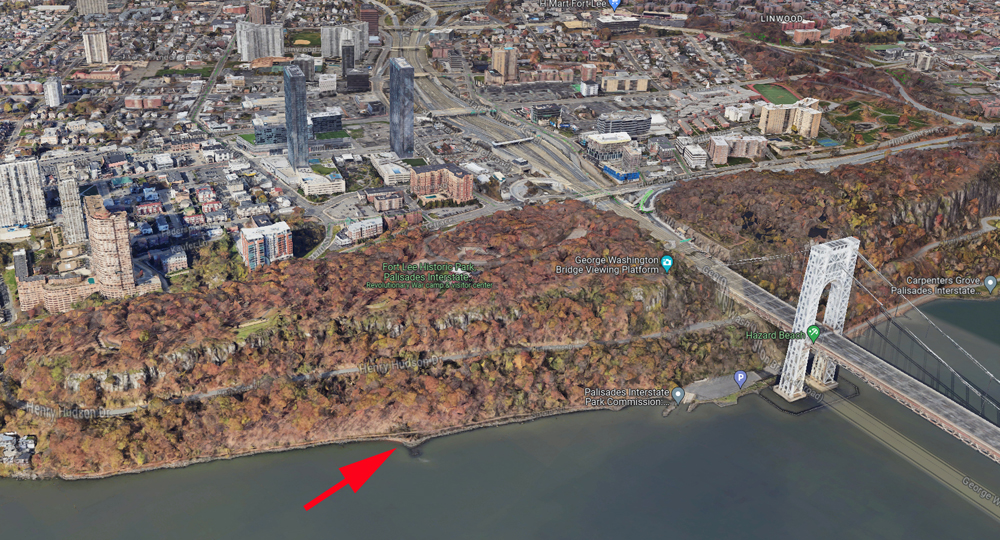
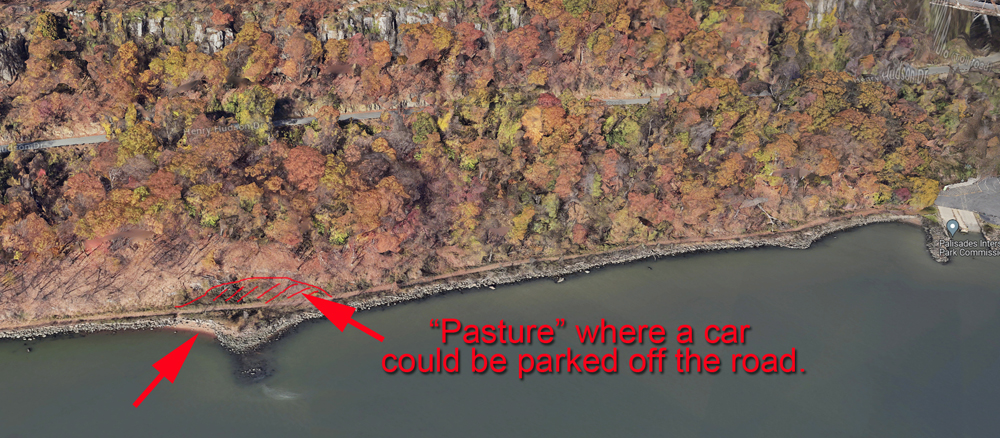
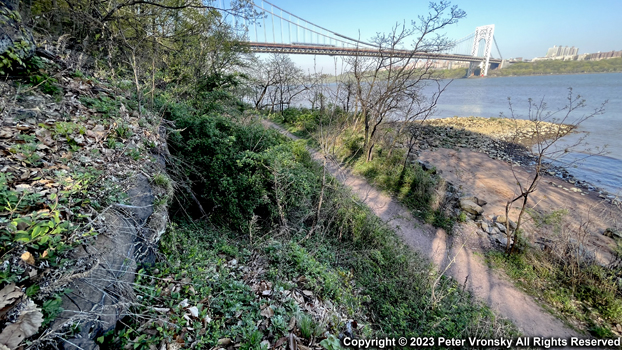
Except when Cottingham got to the riverside, he said the current was flowing
backwards, away from the Ocean, upriver north.
With the sun rising, he decided to instead bury the heads in the ground.
He stated he buried then in near there, next to a Dogwood
tree. A "nice place" for Deedeh's remains, he told Jennifer
although he was vague as to exactly where he buried them, other than on the
other side of the trail.
Cottingham said he used a surplus military entrenching tool
that he kept in the trunk of his car, like the one in the photos below.
It was never found after his arrest in 1980.
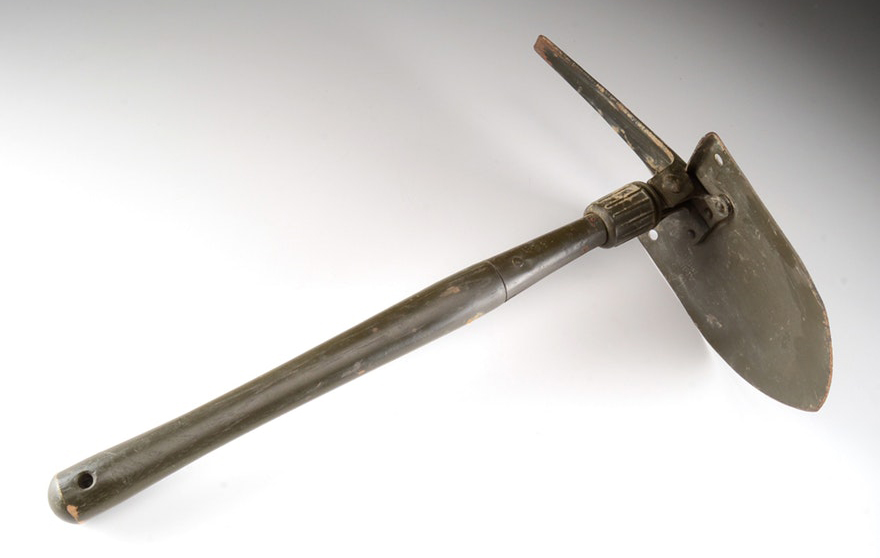
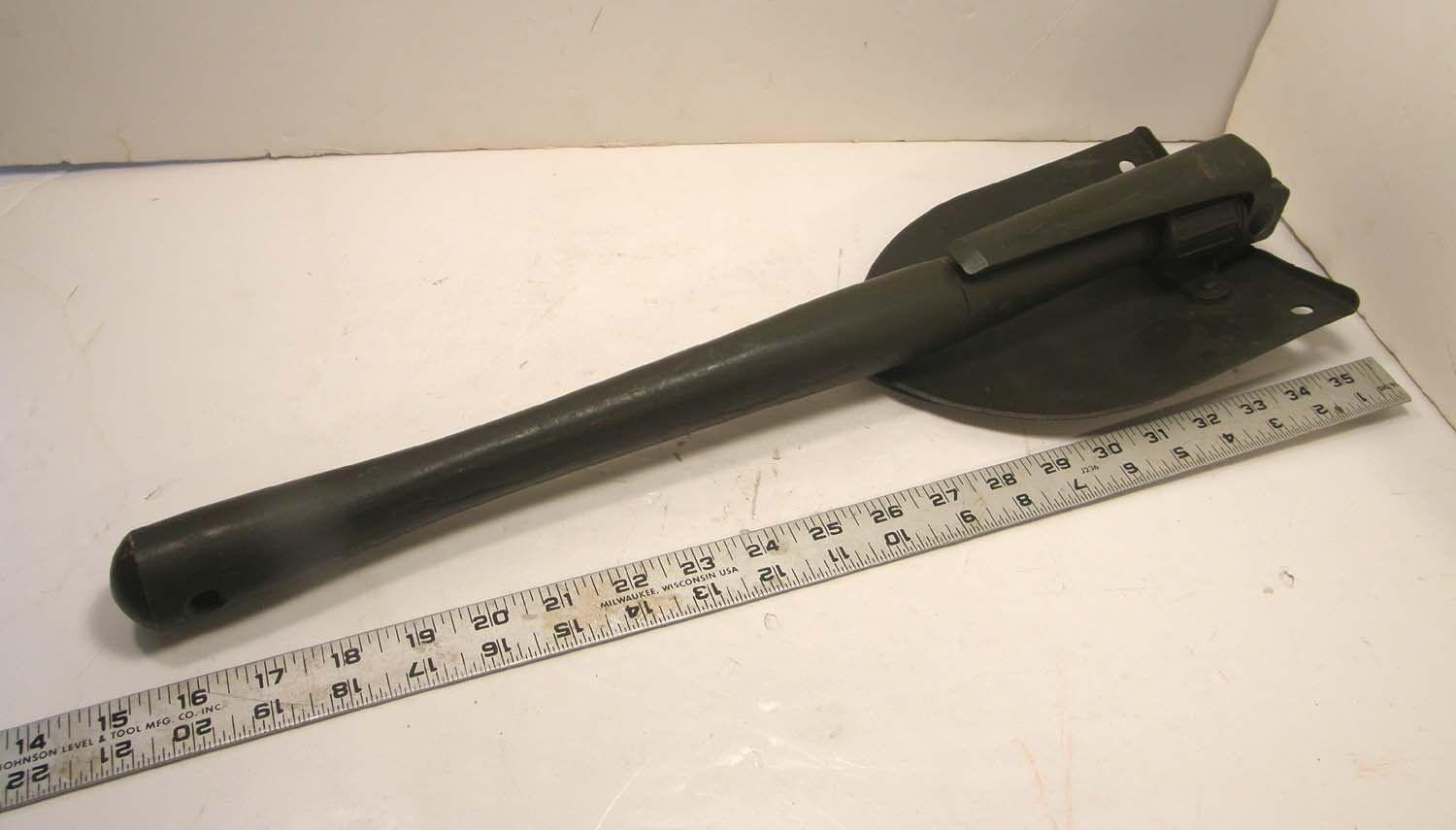
I was very concerned that Cottingham might be bullshitting or manipulating us, as serial killers frequently do, and especially in those early stages of our relationship when I did not know Cottingham very well.
The terrain had changed a little since 1979 and I studied old topographical maps and aerial photos, and weather reports from December 2, 1979, to determine for example, that the ground wasn't frozen that December day making it impossible to dig into. It wasn't. Weather had not yet turned to below freezing temperatures that year.
When I met with Palisades Park rangers, they confirmed that indeed, the Hudson River as a ocean tidal waterway, does appear to flow backwards at high tide. When I checked the historical tidal records at the George Washington Bridge, it was high tide at the time that Cottingham claimed to be there and seeing the water going backwards.
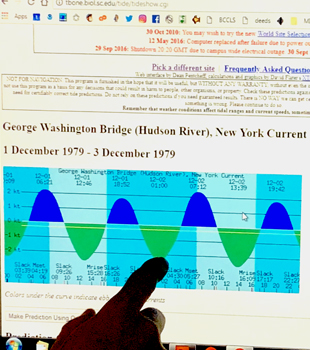
On one of our trips I managed to get help from an Interstate Park Ranger, Eric Nelsen, the park historian-museum technician. He was fascinated by the tale Jennifer and I told and was delighted to come out with us along with some fellow-rangers and museum staff. They gave us permission to dig some test holes with the same type of military entrenching tool Cottingham said he carried in the trunk of his car and used to bury the heads. I had dug trenches when I was in the military, and knew depending on the ground you dig, it could be difficult to dig out a hole deep enough to drop a valise with two heads in it, especially if the soil was stony. We used the same kind of entrenching tool to see if the soil was pliable enough to dig a hole deep enough to drop two heads into in the approximately forty minutes that Cottingham says he was there.
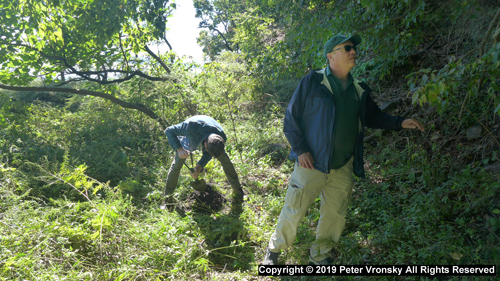
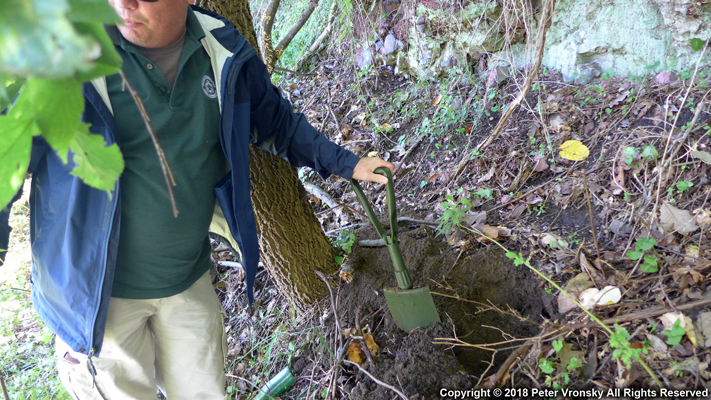
It was possible; the soil was soft and easily gave way. Every step along the way, I weighed the possibility that maybe this serial killer was playing us. Yet his story was checking out. In one way, I wanted him to be lying, because if he was telling the truth, I was then a dope with an overactive imagination, concluding that when I encountered Cottingham as he was fleeing the scene and that he bumped me on the leg with a bag that felt like it had "bowling balls" in it. Maybe it wasn't even Cottingham I ran into!
DEEDEH GOODARZI, MY UNQUIET GHOST AND A "BLOOD
MONEY
TAX"
From
February to October 2018, Jennifer and I made multiple trips to the
location, driving down the twisting cliff road to the shore of the Hudson
River and walking the terrain to where we believed the heads were buried.
During these road trips Jennifer and I got to know each other well and
bonded for life.
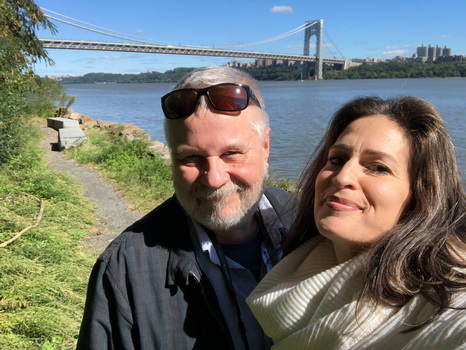
I began to experience a strange phenomenon for the first time, and one I would later experience with another victim family member I ended up going on road trips with, the granddaughter of Lorraine Montalvo McGraw who Cottingham murdered in 1970 and whose murder I would solve in 2022, the first murder I solved of the nine so far, and a significant milestone in my life overall; solving a murder.
Driving around with Jennifer at the Palisades, and in Manhattan where Deedeh lost her life, and in Queens where Deedeh lived as an adolescent and went to jr. high school, I felt, or almost "saw" an ethereal aura coming off Jennifer of her murdered mother, Deedeh Goodarzi. There were moments I felt I was driving with not Jennifer, but Deedeh, looking for her head.
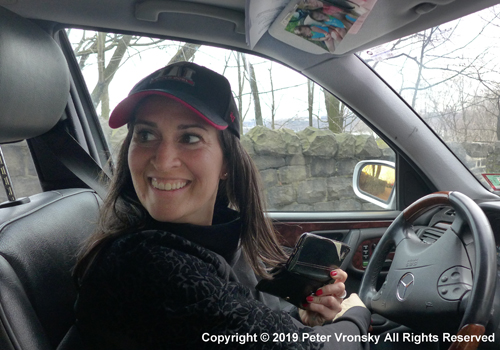
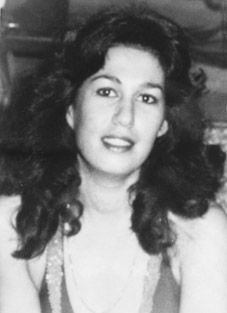
That Jennifer physically resembled her mother further magnified the sensation, but there was more. In the case files, there were interviews with people who described Deedeh and Cottingham had commented how Jennifer not only resembled her mother physically but her 'hurricane' personality as well. Deedeh before she had been murdered by Cottingham was trying her hand at multiple things just like Jennifer was in her life, from modelling to antique dealing. I would joke with Jennifer that there were times she frustrated me enough for me to want to cut her head off. Jennifer and I constantly made these kind of "serial killers need hugs too" graveside-humor jokes.
My connection to Deedeh was further deepened by my having been originally in her physical vicinity in New York on the day of her murder in 1979 and my belief that when I encountered Cottingham in the elevator doors as he was fleeing the scene, he had the severed heads with him and had bumped me on the shins with a bag that he was carrying them in.
I might have been bumped that morning by Deedeh's severed head.
I began to have these 'tales from the crypt' imaginations that perhaps Deedeh's spirit leapt out from her severed head in the bag and attached itself to me and inspired me to later write my book about serial killers that her daughter Jennifer would later read and reached out to me to now be doing what I was doing with Jennifer. The ghostly burr. Or was it five minutes later when I first inhaled through my mouth and nostrils the smoke and tiny black snowflake ashes of her torso roasting on the mattress that were swirling in the hallway when I got off the elevator on the fourth floor from where Cottingham had come down.
And there was a sense of deep guilt too for what came later.
I was paid for describing Deedeh's horrific death at Cottingham's hands in the introduction of a book that became a bestseller and which opened the door for the multiple books I wrote about the history of serial murder and serial killers.
I was making a lucrative living but it was blood money in a sense. Of course, every true crime author, filmmaker, historian, journalist in principle is earning a living from recounting horrific things that happen to victims of every kind, from squalid single murders to mass genocide massacres.
But with Deedeh
Goodarzi it somehow was extra personal, and Jennifer Weiss her daughter
reaching out to me was something spiritual and supernatural and I still feel
that way to this day.
I felt I was paying off my 'blood tax' to Deedeh through the project I entered
into with her daughter Jennifer.
WATCHING THE DETECTIVES: TRYING GET A RESPONSE FROM LAW ENFORCEMENT ON "TORSO JANE DOE"
Getting law enforcement to respond to all this was a different
story.
When I was in New Jersey on my first visit in
February, Jennifer tried to call BCPO Chief Anzilotti whom she had met previously.
She wanted for us to pay him a visit together while I was there
to introduce me to him.
Anzilotti did not return her calls.
When I got home to Toronto I
later wrote both Anzilotti and District Attorney Dennis Calo (who had back in 1980
prosecuted and convicted Cottingham) that I was writing a book about
Cottingham and would like to interview him and review the trial transcripts.
Calo had appeared on camera in interview in the 2009 French documentary that
Nadia Fezzani was featured in next to a pile of the trial transcripts.
Calo responded that BCPO was
not interested in talking to me and that the transcripts were not available. Anzilotti outright ignored my
calls and e-mails.
Next I turned to the New York Police Department (NYPD). Technically, the Times Square Torso Cases were closed and Cottingham had been convicted back in 1984 at trial without the severed hands and heads being found.
New York State had no judicial interest to locate the heads
now, they convicted Cottingham without them, except the “Torso Jane Doe”
still remained unidentified. That was the thread that my effort to recover
the heads hung on.
From February to October I struggled to get anybody to take a call from me
at NYPD
about the severed heads, the location of which by then I
pinned down to an area of approximately 250 square feet. I knew this
was something for an NYPD cold case detective and from media accounts and press
releases, I culled the names of some cold case detectives. But NYPD
can be a closed fortress to outsiders, a hermit nation unto itself like
North Korea, and even if you know a detective's name, it is almost impossible
to get their phone number unless it's out there on a particular case where
they want you to call with information.
If you call the NYPD switchboard and ask for a
Detective by name, they ask you, "what is his extension?"
"You are the switchboard, can you look it up, please?"
"No, we don't do that."
"But this is important, how do I find the detective to contact them?"
"If it's important, they will find you and contact you."
My publisher Penguin Random House had published Stacy Horn's 2007 book, The Restless Sleep: Inside New York City's Cold Case Squad and I asked them to put me in touch with Stacy. She surely had numbers and contacts with cold case detectives. After hearing my story, Stacy put me in touch with the legendary NYPD Detective Wendell Stradford, the detective credited as the founder in 1996 of the NYPD Cold Case Squad about whom she had written extensively. (Prior to 1996, the NYPD did not have a dedicated cold case unit.)
Wendell Stradford had solved in his 37-year career at the NYPD over 100 murders and when I contacted him the October 2018, he was no longer on the cold case squad but now near the top of the NYPD's chain-of-command, working in the Office of the New York City Police Commissioner. You don't get much more juiced up at NYPD than the Police Commissioner's Office.
Wendell was very familiar with Cottingham and as a cold case detective in the past, looked into unsolved murders Cottingham might have committed in New York. He readily agreed to meet me for breakfast at my midtown Manhattan hotel, to assess first hand what kind of bug I might be. After hearing me out and looking me in the eyes to weigh just how crazy I was, Wendell immediately agreed to help get NYPD on board, and assured me that he would get somebody from the Cold Case Homicide Squad to get in touch with me right away.
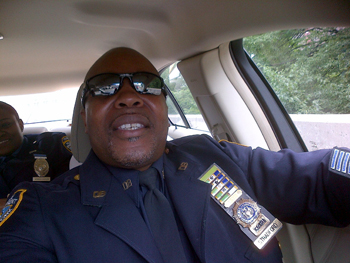
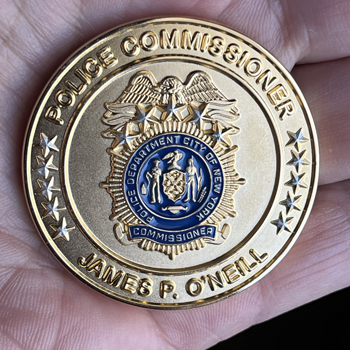
That morning over breakfast, Wendell furnished me with a secret to share with Cottingham that significantly impressed Cottingham early in our relationship and demonstrated to him the depth of my utility to him and my reach to cops.
On parting, Wendell pressed a gold 'challenge coin' into my hand from the New York Police Commissioner's Office. Challenge coins are a currency of courtesy in the US military and law enforcement, emulating an ancient tradition from the Roman empire, when soldiers who distinguished themselves, were given a gold coin as a token of respect and esteem. It's treasure totem from my life. (Wendell retired 2021 and currently works as a technical advisor on the TV show Law and Order.)
BILL SIMON NYPD COLD CASE HOMICIDE SQUAD
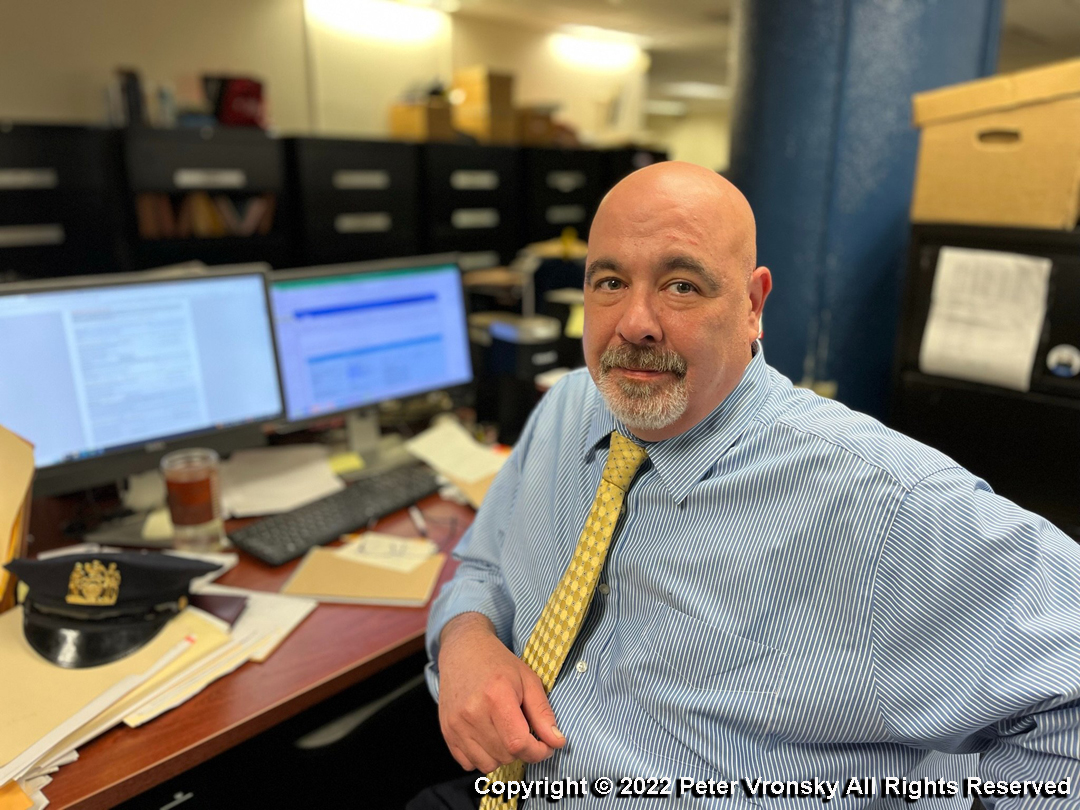
The next day, I got a call from Detective William “Bill” Simon of the NYPD Cold Case Homicide Squad based on Gold Street in Brooklyn.
Bill invited me to come down to meet him at his office. I came in the next day on October 17, 2018. After an hour of listening to my pitch, Bill asked, "what are you doing right now?" I said, "I am here to see you; I am at your disposition." Bill said, "let me change out of my suit, and we will go there to the scene, I want you to show me exactly where you think the heads are."
Bill changed into his jeans and donned a maroon color hoodie sweatshirt, and we now took an hour long drive from Brooklyn across the river into New Jersey and the Palisades Interstate Park under the George Washington Bridge. On arriving at the entrance to the Palisades Park we drove down twisted route and walked the path that Cottingham told me he took and into the bushes in the terrain where I thought Cottingham buried the heads.
I had written a twenty-page illustrated report that I had initially shared with Wendell, who sent it on to Simon, on why I thought the heads were buried at that location. One of the things Cottingham had said in his text was that he had buried the heads next to a Dogwood tree. The lifespan of a Dogwood tree is around 30-80 years on average, and while I focused on many factors, I made the Dogwood tree my lowest priority, thinking that in that terrain there would be many Dogwood trees, and most likely the Dogwood tree Cottingham was referring too had expired over the years. I focused on all the other geographic factors, hardly mentioning the Dogwood tree at all. On the prior trips that Jennifer and I made to the location, I didn't even bother checking references as to what a Dogwood tree looked like, figuring it was pointless.
When I walked Bill into the 250-square foot 'pasture' beneath the Palisades cliff face where I suspected the heads might be, the first thing Bill did was point to this single gnarly old tree in the middle of it, and say, "Dogwood tree!"
As Bill began beating the brush surrounding the tree I whipped out my cell phone and did something I should have done six months ago. I began Googling "Dogwood tree." I then snapped a few pictures of Bill, his shiny bald head like a bulldog's pushing aside the brush around the tree. Bill was muttering, "corpse mushrooms. Corpse mushrooms." He explained to me that he was looking for a species of mushrooms that thrived on minerals deposited in soil from decomposed corpses or dead animals, and once they emerge they grew there forever.
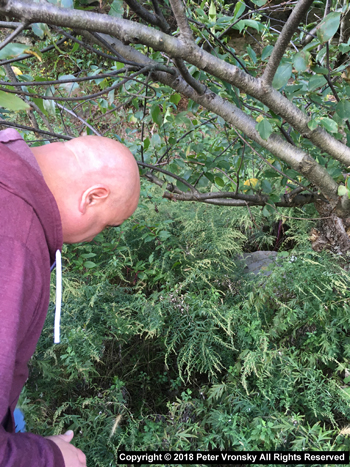
The next day, Detective Simon
reopened the case to recover the heads, with the purpose of trying to
identify the "Torso Jane Doe" buried with Deedeh's head and initiated plans to make a search
with BCPO on the New Jersey side of the Hudson River. It was going to be jurisdictionally
complicated, because while the unidentified girl was technically an NYPD case, the
location of her and Deedeh's remains were in the joint jurisdictions of BCPO,
Bergen County Sheriff's Office, Fort Lee New Jersey Police Department and
the Interstate Palisades Park Police, a formula for what is affectionately
known as a "cluster fuck."
I had no sense of how serious they were
and if any search was going to be ever carried out. It was like a dream.
But once NYPD reached out to Chief Anzilotti at BCPO in October, and my name came up, now Anzilotti suddenly began returning my calls and texts after having rebuffed my calls for months. He was like a woman you wanted to date, who ignored you until she saw you dating other women.
Anzilotti and I met in person for the first time in October 2018 before I returned to Toronto, the first of dozens of meetings Rob and I would have between 2018 and 2021 and hundreds of phone calls, texts and e-mails about Richard Cottingham cold cases.
I was in finally on both sides of the Hudson River, after nine months of being rebuffed by
cops everywhere.
I am forever in debt to Stacy Horn for opening the door for me, and Wendell
Stratford
for hearing me out, and to Bill Simon for daring to go into the craziest
uncharted territory where nobody else dared to go.
Bill Simon retired
from the NYPD in August 2022, but today Bill
and I work together with the NLIJ - the National
Institute of Law and Justice dedicated to assisting victim
families who feel that the murder of their family member is not getting the
investigative attention they deserve.
JENNIFER AND BCPO CHIEF OF DETECTIVES ROBERT
ANZILOTTI
Jennifer
had already met Chief Rob Anzilotti at BCPO before she and I began working
together.
Anzilotti who was working on Cottingham cold case murders since 2004,
was interested in somebody who was visiting "his perp" and met with her and
listened to her story how she was the daughter of one of Cottingham's victims,
was visiting him now,
and how she thought she might be Cottingham's biological daughter.
Anzilotti
did not like what he was hearing. It was too unusual, even for a cop.
On my first trip to New Jersey in February 2018, Jennifer tried to bring me in with her to visit Anzilotti but he would not return her calls. And he did not return my calls either.
One day in late summer I drove Jennifer to a sudden appointment she had with him and his partner Jimmy McMorrow at BCPO field headquarters in Paramus. By then I had been formally rebuffed by e-mail, they were "not interested in participating in my book project or meeting with me." I waited in my car while Jennifer went in. Forty minutes later she came out seething in rage at how she had been treated. Apparently McMorrow (the "bad cop" in Rob and Jimmy's bad cop/good cop Mutt & Jeff routine) challenged whether she really was the biological daughter of Deedeh and accused her of being a "little scam artist looking for fame." Rob did not appear to take her seriously. Jennifer cursed them both out and stormed out of the building.
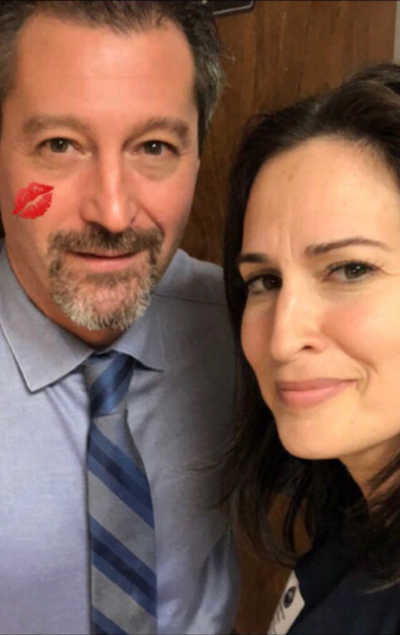
Robert Anzilotti from the beginning had been suspicious and wary of Jennifer Weiss. He never met anybody like her, nor could he understand the relationship that had developed between Cottingham and Jennifer since she began visiting him in the spring of 2017, and how quickly it had flourished and blossomed. Perhaps he was jealous of the speed and ease with which she built a level of intimacy between herself and his suspect-target whom he had painstakingly been "working" and "handling" for sixteen years. (Not realizing that his target Cottingham, had actually been working and handling him.)
Rob was very 'possessive' of Cottingham, obstructing attempts by other detectives, even from his own jurisdiction from interviewing Cottingham. And even after he retired in April 2021. (See Part 4: Closing the 1968 Jackie Harp Cold Case Murder.)
Part of the problem too, was that Jennifer wasn't faking it
with Cottingham, while Anzilotti
was. He couldn't do what Jennifer could; get to Cottingham's heart. There was a strange inexplicable seething
petty hostility toward Jennifer from Anzilotti that to this day, neither I, nor
even Cottingham who manipulated and played Anzilotti for sixteen years,
can understand. We even ventured a crazy theory that somehow his hostility
to Jennifer was related to the fact that she had almost the exact same name
that Anzilotti's wife has - Jennifer Anne Weiss vs. Jennifer Ann Weiss!
Rob often advised me to “dump Jennifer”, disassociate myself from her,
arguing that working with her was harmful to my reputation and reflected
badly on my credibility. There was bad blood between those two and I don't know why and the
closer Jennifer came to dying the worse it became.
It
made no sense, and still today as this is being written, it makes no sense
why Anzilotti and BCPO will "bury" everything Jennifer did to assist them
later in the historical closing of the 1974 cold case murders of Lorraine Kelly &
Mary Ann Pryor in 2021 and Mary Ann
Della Sala in 2022. Those cold cases would have never been closed
without Jennifer Weiss. I on the other hand, had no problems being credited
by BCPO without asking for it and was given everything promised me in return for
my assistance in the case closures in Bergen County to come in 2021-2022.
I never understood that, and it makes me feel low to so criticise Anzilotti,
because with me as long as he was Chief, he came through on everything. I
walked away from it with everything I had needed, to write my book and make
my documentary. It was after he retired in April 2021 and
entered the private sector that he betrayed everything we had built in our
rapport between 2018 and 2021, regardless of his disdain for Jennifer.
I bear Rob Anzilotti no personal grudge, but upon his
retirement he ended up royally fucking over Jennifer and multiple New York
police departments, or at least standing aside and letting his successors at
BCPO do so in June 2021. (See Part
10: New York Betrayed by New Jersey: Closing the Kelly & Pryor 1974 Cold
Case Murders in Bergen County.)
THE FIRST SEARCH FOR THE SEVERED HEADS, JANUARY 3, 2019
In Dec 2018 - Jan 2019I returned to New Jersey during a break in my lecture schedule at my
university for the Christmas-New Year holiday weeks.
The several week long holiday break and semester change-over, would give me an opportunity to visit again for
several weeks with Cottingham inside the prison. I assumed that a search for
the severed heads, if it was going to be undertake, would be made in the spring at the earliest,
imagining it would take months to
organize and they would wait for weather would be better. But mostly I
imagined it would never happen.
But
on the morning of January 3, 2019 I suddenly received the following text
message from Chief Anzilotti:
"Good morning. I want to let you know Richard will be up by me today.
It has been scheduled for several weeks. Obviously he was unaware for
security reasons and I could not tell you yesterday. I'm glad you are
in town. If you like, I will make time for you to speak with him at my
office this afternoon of this evening. Please do not tell Jennifer.
I will call her later and advise."
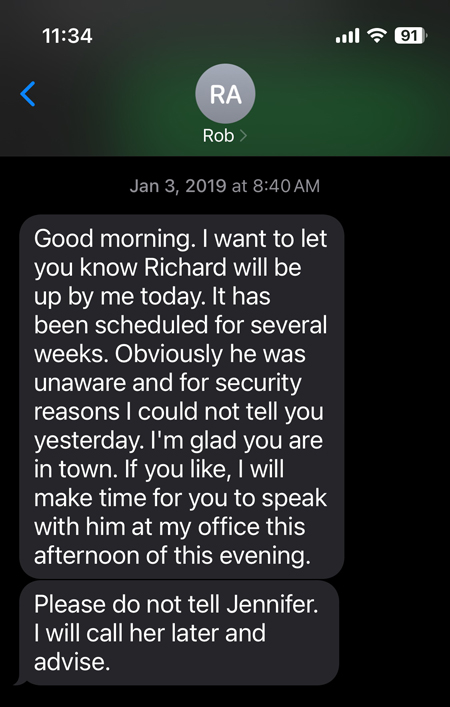
Anzilotti really did not want Jennifer to be there. When I called Anzilotti, he told me they were doing the search for "your heads."
Regardless of Anzilotti's request that morning not to tell Jennifer, I intended to bring her with me just the same to be there with Cottingham and me. I told Rob that Jennifer already knew, that she went that morning to visit Cottingham in prison and was told he is not available for visits and she surmised he was at BCPO and was already getting ready to drive up there and 'crash the party.' I said I was going to "cut her off at the pass" and take her in my car, lest she show up all loose canon on her own. (Half true, she did try to visit him that morning, but when she was told he wasn't there, she had called me worried that Cottingham was in hospital.)
It was fait accompli that Jennifer was coming.
An opportunity of meeting with Cottingham in Paramus, unsupervised and not closely monitored the way our prison visits were in limited contact visits, was a rare opportunity for Jennifer and me, because Cottingham could talk more freely without corrections officers looking over his shoulder and keeping time on ninety minute contact visits that were limited to only two visits per week, on weekends. (Visitors are allowed two contact visits on a weekend plus two "window" visits per week behind glass on telephone handsets. Those glass booth handset conversations were automatically recorded by the Department of Corrections, and Cottingham was not comfortable therefore to speak freely.)
At the last minute that morning before I left my motel
to pick up Jennifer to drive up to Paramus, I did an amazing thing without
thought: I tossed a video camera into my
backpack. It was done spontaneously, I did not even know if the batteries had
been full charged, I had no plans to film that day, and I almost robotically
took the camera with me with no intended purpose, not even remotely
imagining I would be allowed to film anything.
Jennifer and I were not permitted to attend the search.
But Rob told me
to stand by near the Paramus BCPO field office and wait. He would call me
in when Cottingham would be brought
back back from the search site to the
office for lunch before being transported back to Trenton Prison at the end
of the day and we could have some time with him. Jennifer and sat over coffee near the BCPO offices waiting for
Rob to call me in.
I never told Jennifer that Anzilotti did not want her there, and I don't think she ever found out. I just brought her with me. Period.
Finally Rob called for us to come up, and Jennifer and I checked through security with Rob waiting for us in the lobby. As Rob was walking us to Rich, without thinking about it much, I asked Rob if I could videotape Jennifer and Cottingham. After a momentary hesitation, Rob said "Sure, if Rich is okay with it." It was an enormous gift and I am sure these days Anzilotti deeply regrets giving it to me.
THE COTTINGHAM JENNIFER VIDEO
We were led into an interview room where Cottingham was seated with pizza.
He had just been brought back from the search site under the George
Washington Bridge. Rob left us with him with one other cop seated inside to
keep an eye on us. I assumed that Rob was watching and listening on
the video cameras and microphones installed in the interview room and
probably recording us.
Cottingham was surprised to see Jennifer and me walk in. He was already in a state of shock, looking like a deer in the headlights, because he never imagined that the police would actually conduct a search excavation for the heads. (Anymore than I imagined it was going to happen. It was like a dream.)
I asked Cottingham if I can videotape him and Jennifer, but at first he refused, primarily because he is shy!
Cottingham told us that there were some thirty cops at the scene with a mini-excavator, a New York City Medical Examiners truck in case they find something, a NYPD CSI truck, a police K9 cadaver dog, and a BCPO command truck for cops to make coffee and warm up. It was going to be a two-day search. Later that day I called Bill Simon, and he told me not to go down there, because if "they find something there, we don't want to suspect that you and Jennifer planted it there. Don't contaminate the scene."
I had not talked with Simon since our meeting in October,
and he did not know me well enough at that point, to let me in on the fact
that a search had been organized and underway. Anzilotti extended that
courtesy to me on the morning of the search. No matter how closely I would
come to work with cops, I always had to accept that I was an outsider - a
'civilian' - and work with the limits they set inevitably.
We talked with Cottingham for about ten minutes, him marvelling at what I
managed to mobilize and that Jennifer and I were there with him in the room and I
then appealed to him again, reminding him how rare this opportunity was to
shoot some video unsupervised with Jennifer and him. Maybe the only
chance we get, I said. Cottingham relented this time and agreed and I rolled
about ninety minutes of video as he described the search for Jennifer's
mom's head and we talked about all sorts of things. After ninety
minutes, Anzilotti came in and told us it was time to take Cottingham away
back for the drive to Trenton State Prison and it was time for us to leave.
I would never get Jennifer and Cottingham on camera together again.
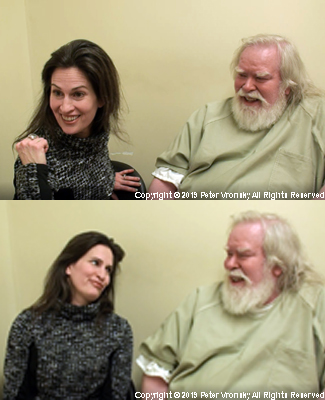
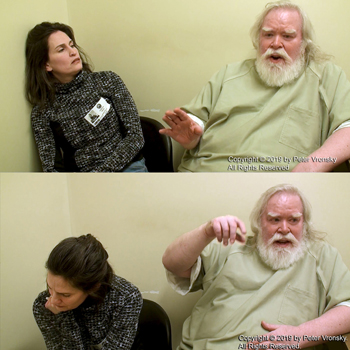
THE RESULT OF THE SEARCH IN 2019
The the two-day search failed to find the heads.
Partly it was my fault, in that I missed by approximately 20 yards and further upslope on interpreting Cottingham's verbal description of the location where he thought he buried the heads, Cottingham later told me.
Partly it failed because the police at the scene, according to Cottingham,
did not ask him the right questions when they brought him to the location.
Cottingham is very verbally pedantic. Cottingham said, "they
asked me the wrong question when they brought me out there. They pointed to
an area marked off with yellow tape and asked, 'Is that where you buried
the heads?' and I truthfully replied, 'maybe.' But what they
should have asked me was, "Where did you bury the heads and I
would have shown them where I thought they were buried. Close to where you
sent them, but another 20 yards or so further up the slop."
The pedantic serial killer's
gamesmanship. A word out of place and Cottingham shuts down. For example, if
I say I "mailed" something to him, while I actually "e-mailed" it, he
digresses into minutes of precious time to lecture me on the difference
between an e-mail and a mailed postal letter.
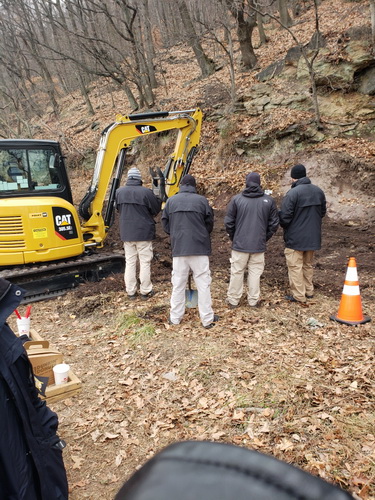
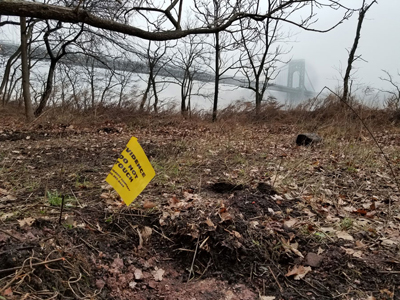
I also believe, that the police should have used a different kind of canine search dog, although they disagree with me. The 'cadaver dogs' they used are trained to detected decomposing human bodies and the gas and scent they give off as they decompose. But the heads were buried in 1979 and had decomposed decades ago! The process of decay was over. What I argued and still argue we needed, is MIA (Missing in Action) military archaeological cadaver dogs used to located soldiers lost in the Pacific during World War Two, in Korea and Vietnam.
MIA archaeological dogs are trained to recognize the presence and trace of human decomposite, minerals and chemicals mixed into the soil (kind of like Bill Simon's 'corpse mushrooms'), not the actual human remains which would have decomposed over the decades. Not only have these dogs successfully found missing GIs from World War II in places like Guadalcanal, in Korea and Vietnam, but also in Europe from World War One battlefields. I learned that archaeological dogs have been able to successfully smell out on stone human remains leading to 3000-year old tombs in Croatia! A dog's nose is a miracle of nature.
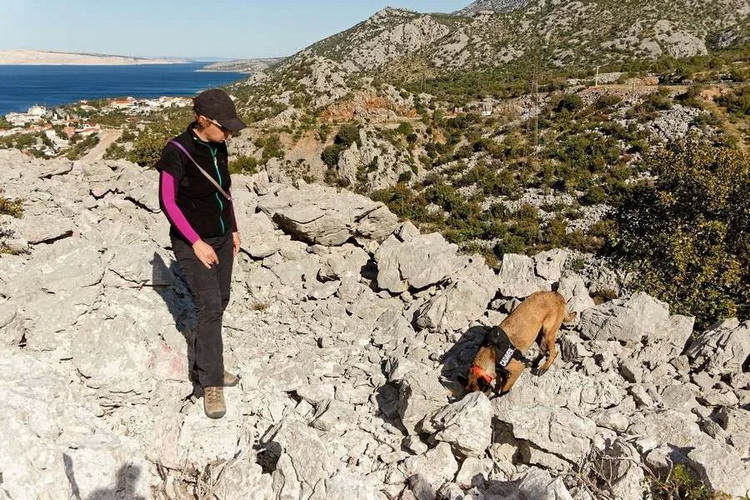
Archaeological dog sniffing out traces of
3000-year-old human remains.
(Department of Archaeology, University of Zadar)
But most of the MIA military archaeological dogs are deployed in the Pacific and therefore kennelled on the West Coast, and we would have rent and fly the dogs out to New Jersey. Cops on the east coast don't have those type of dogs nor the resources to fly them. (The TV company I am currently working with is prepared to budget for this, and other things that a police department cannot afford.)
And even then my proposal has one major flaw to this day. If the heads were in a non-biodegradable vinyl valise, would it not collect all the decomposite and prevent it from mixing with soil the dog is trained to detect?
WE SEARCH FOR THE HEADS AGAIN IN 2023
Over the years since 2019, Cottingham elaborated further with more
precise information about the
location, and in April and May 2023 a new series of searches were initiated.
This time not only was I part of the search team, I essentially led it.
At the end of April I returned to the location to do another survey. Jennifer was dying of brain cancer but still conscious and able to follow the unfolding search. I kept Jenn 'with me' as I did the survey again, our last, keeping her online on video and sending pictures photos. She was aware and knew exactly where we were, having been there at least ten times including the last time Jenn and I saw each other in person, in August 2022 - about nine months before her death. Although she had been showing signs of 'something' who the fuck would have thought it was something that would have killed her. She climbed up and down the Palisades Park hiking trail with me - 35 stories down and then up. We shot a lot of video together - four days worth - on her last summer, the summer of 2022. It's eleven months since her death on May 28, 2024 as I write this.
Cottingham chided me for concluding that he had buried the heads in "the pasture." The heads were, he said, about another 25 yards south from pasture and upslope.
In late April 2023 we arranged for me to be there on site when he called me on my cell phone. He told me to look for a 'sort of' trail near where he parked his car and where Dakota Dog Beach is, that went up the slope toward where the cliff face came straight down. He said he went up that trail about 30 feet or so and buried the heads there.
At first could see no obvious trail or easy place to climb up the steep slope.
But I had done this once before, some thirty-six years ago, climbing upslope with a metal detector beneath a medieval Cather heretic fortress is the south of France, Montsegur in the Languedoc, where the Holy Grail was said to have been secreted until 1244 when the First Inquisition came for it with a crusading army and besieged the castle. A local mountain guide showed me how to recognize old mountain climbing tracks from the siege times. They were 'natural' paths - there by luck - that anywhere else along the cliff side you'd break your neck trying to navigate.
I knew now what I was looking for and when to look for it; when the sun is low and casting long shadows you can see smaller graduating arcs contrasted in the terrain, like altitude lines on a topographical map; interconnected bends and bulges in the shadows where the slope is on a less steep incline.
If God and/or Mother Nature (if they are not the same thing) are on your side, the inclines interconnect into a natural pathway up an otherwise an impossibly steep slope. The kind of pathway you could climb, carrying a sword and crossbow, or a rifle, ammo and water, or a metal detector and a camera, or a 20-lbs bag of severed heads and hands and an entrenching tool in one hand, and use your other hand to brace and pull oneself up the slope.
Gradually in the long shadows as the sun was setting behind the cliffs, my eye discerned a 'natural' route up the slope, an organic trail overgrown by brush, but clearly there. 'The only way up.'
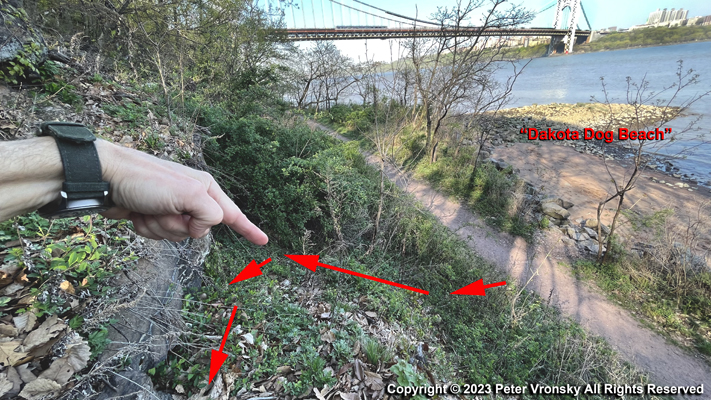
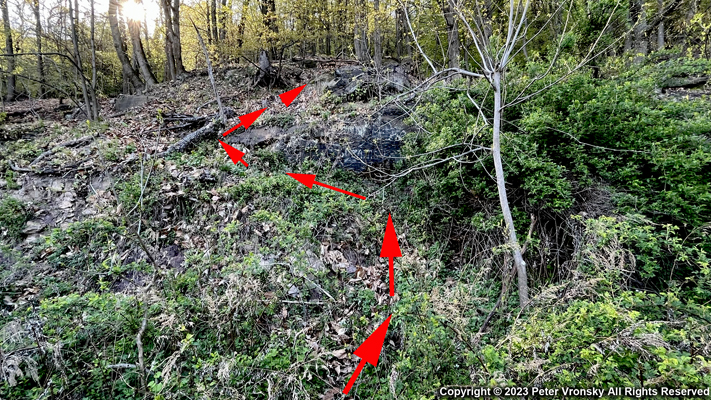
The next day I took a squad of volunteer active NYPD officers and retired officers and investigators from the NLIJ, including Mark Pucci the founder of the charity and Bill Simon who had retired from the NYPD in 2022 and was now the lead investigator at the NLIJ. Somebody brought in a trained cadaver dog for the occasion, assuring us that it would detect the remains even if they had decomposed fifty years ago. I did not look a gift horse in the mouth, although I still had doubts which I kept to myself, as did another volunteer on the search who owned a trained dog and knew more than I did about the K9 trained dogs and how to handle them. But I still think we need a 'archaeological/MIA grave' type of dog.
All the NYPD cops were there on their own time, determined and dedicated to finding "Torso Jane Doe" and bringing her home to her family, NYPD officers with hearts of gold beneath their blue dented and bruised armor.
I brought along the same Garrett metal detector which I used to have in Europe when I lived and worked there, and would spend weekends exploring Roman ruins in southern Italy, or searching for gold bullion left behind by retreating Nazi troops in northern Italy where my in-laws lived, or at that medieval heretic castle in France, with nearby ruins of Templar preceptories and Albigensian Crusade battlefields, where I was searching for the Holy Grail; literally. (And the Holy Grail is not a chalice; it's dead body from one of the oldest unsolved cold cases in the last 2,000 years.)
I found a few very cool precious things, but mostly I'd climb up into the most remote hilltop ruin and pull up piles of zip-tops from old beer and soda pop cans and nails. Once I found an unexploded grenade. I brought it with me in the hope to maybe detect the metal clasps of the valise. Cottingham also told me 'he might have' tossed in the handcuffs, and maybe even the hacksaw he used to sever the heads, which would 'read' well on a metal detector.
My metal detector served me faithfully since 1987, but on this day in April 2023 as we started the search, it irreparably died on the spot as if the Palisades did not want to give up their dead. And the Palisades are rife with the dead, especially 'Suicide Woods' off the undersides of the bridge, where people throw themselves off the bridge and get stuck up in the branches and nobody sees them until the end of autumn as the leaves come off the trees, exposing two seasons worth of suicides; the annual harvest of the dead.

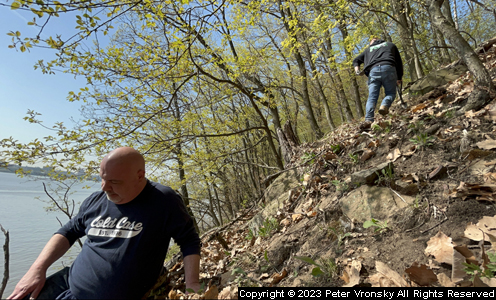
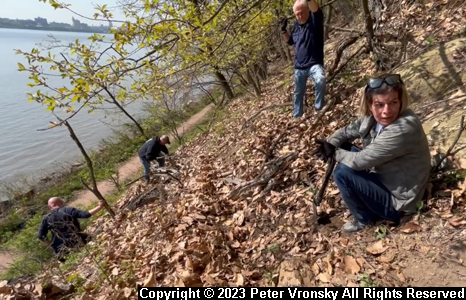
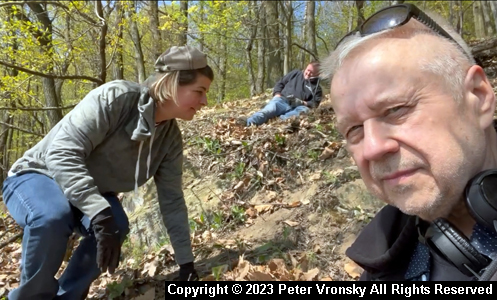
The path existed. I was not imagining it. It was a completely natural unmarked trail that tens of thousands of people must have used over centuries, perhaps millenniums when Indigenous peoples lived here.
Before the George Washington Bridge was built in 1927-1931, there was a ferry there to Manhattan and a pier - Hazard's Landing - that still functions there today it was both an industrial site for gunpowder production during the First World War, and a popular beach bathing and recreation area. Even with my metal detector dead, just random scrapes around the terrain where we clambered up, gave up big fragments of 19th century decorative bottle glass. People walked this way. A lot. This was the trail Cottingham was talking about. It was real. But does that mean he buried the heads there?
Cottingham had come down often to the Palisades Park, even as a kid and a cub scout, and it was a bus ride away of an adventure going down there, and later a spectacularly romantic spot for a date, and yes, a great place to leave some severed heads too.
Was he making up a story about the heads on a terrain he was familiar with and could describe well enough to lead me to it?
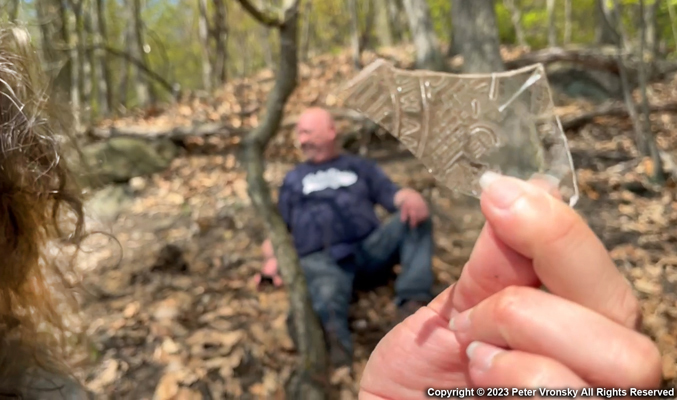
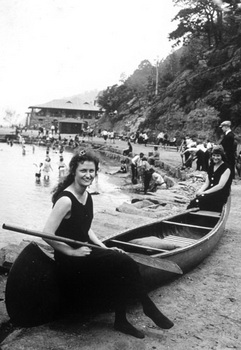
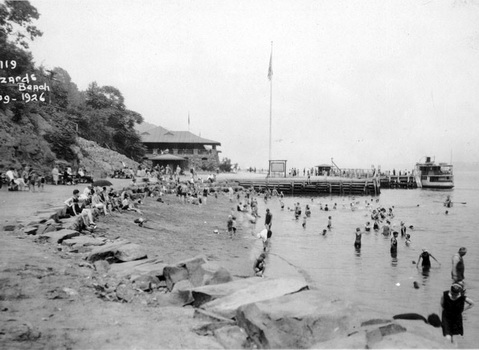
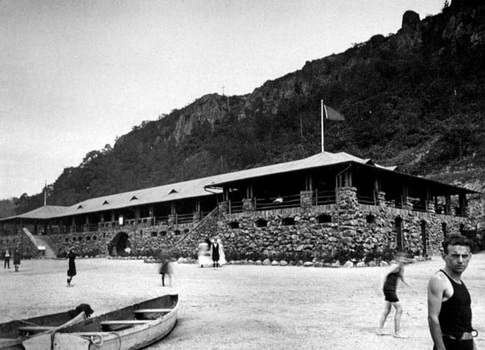
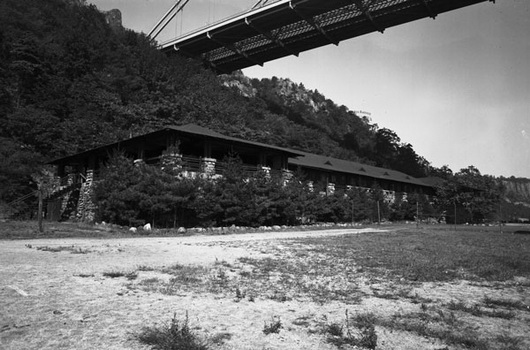
WHO IS "TORSO JANE DOE"
Interviewing Cottingham is not easy because he does not have complete
recall, but often is 'reminded' of things, memories triggered while in
ordinary conversations or while focused on another case. (See
Part 1a) So I would often return
to what else he could remember about "Torso Jane Doe."
She was not from New York, Cottingham said. She had recently arrived either from the Midwest or the South. She was "fresh" and naive, open to anything, "dizzy." Cottingham had both Deedeh and Jane Doe in his room since early Friday to Saturday morning (Dec 1) and they had breakfast together and spent the day in the room.
At 5:00 p.m. Dec 1, Cottingham said he left the two women alone in the room to go down and making a bet on a horse race at an off-track betting place nearby and bring back some dinner. This was about six to eight hours before he cut their heads off! The two women were left alone in the room but after about 18 hours with Cottingham, they apparently had no reason to flee. They waited for him to come back.
Cottingham said that when he returned to the room, "Jane Doe" was sitting cross-legged on the bed watching cartoons. "That's how she was," he said. They then watched the horse race on TV live from the Aqueduct at 6:30 p.m., he recalled.
I looked at the TV listings for that day. The horserace was broadcast on Channel 9 at 6:00 p.m. actually. From 5:00-6:00 p.m. on Channel 11, there was a "Mr. Magoo Christmas Carol" cartoon.
As we were searching for the heads in April, Cottingham kept phoning and
texting me about how the search was going. He then remembered that "Torso Jane
Doe" had told him she recently arrived in New York and had been
arrested for the first time in the previous week. She had been ROR -
Released on Recognizance, no jail or bail, something that often occurs on a
first-time arrest. But he did not know in what precinct or the exact
date.
That unleashed a massive and difficult 'needle-in-a-haystack' records-search
in the NYPD archive by one of the volunteer cops, who attempted to locate prostitution arrests
in the week before the Torso Killing on December 2, 1979. "Torso Jane
Doe" would have to be a girl who was arrested, released on ROR, and after
December 2, would have never shown up again in arrest records. With
approximately 40,000 sex-workers working daily in the streets and massage
parlors of New York, there were a lot of daily arrests to go through.
(See:
Claire
H. Cooney and Janet Quint, Prostitution in
New York City: Answers to Some Questions, Publication
of New York Women in Criminal Justice in collaboration with the Prostitution
Task Force: New York, 1977.)
A lot of the records from the 1970s, had long been destroyed or lost, even
homicide files, let alone arrests of sex workers.
Because the NYPD detective was volunteering and was not assigned to the Cold Case Homicide Squad, within a week of initiating the search, they were shut down, and told by the 'bosses' to concentrate and focus on their 'assigned' duty. Leave it to the Cold Case squad. Except with Bill Simon now retired, nobody replaced him on the Cold Case Squad - it was being slowly eliminated by the new post-Pandemic regime in the Mayor's office and the NYPD. Cold Cases are no longer a priority they had been.
Two more searches in April and in May 2023 and again, no success, but as this is being written we are getting ready for a fourth search since the original big dig in 2019. We will find those heads unless floods, or geological shifting had somehow forced the heads out into the river, or animals had gotten to them when they were first buried there, or as I feared since the beginning, and still have a nagging sliver of doubt about, did Cottingham sell us a bullshit story?
Jennifer would have
done anything to be clambering up the slopes beneath Palisades with us that
spring, and she
was still conscious and aware enough to keep up with the
last searches on her cell phone as I texted her photos and video from the site as
the search was
taking place, among some of my
last conversations with her before she tragically died on May 28, 2023.
IS COTTINGHAM TELLING THE TRUTH ABOUT THE HEADS OR SERIAL KILLER
GAMING US?
Serial killers of course thrive on manipulation and control. They
pathologically lie, not because they have to, but because they can and
that's what they do. If that is the case, if Cottingham is lying, then
I suspect the motive is less about control and more about his feelings for
Jennifer and some sense of pride having locked into a story that he first
told Nadia in 2009.
There was nothing in the details that Cottingham gave about the location and circumstances that confirms he actually buried the heads anywhere near there.
The most compelling thing about his story was his observation that the river appeared to be flowing backwards and the tidal record confirming that it was high tide at that time. But that could have been a 50/50 chance lie, that it was either high tide or low tide. A 50/50 gamble, a one out of two odds. Like flipping a coin once, if he was going to base a false story on the backward flowing river.
I still to this day have questions and doubts about him risking the long drive with the severed heads in his car from 42nd Street across the George Washington Bridge and making the drive down the twisted Palisades Park cliff-side road to the banks of Hudson River, tired and burned out after a day and night of holding two women captive in a hotel room, raping, torturing, murdering, mutilating and hack-sawing their heads and hands off their torsos and setting them on fire, and fleeing the hotel with the heads and severed hands.
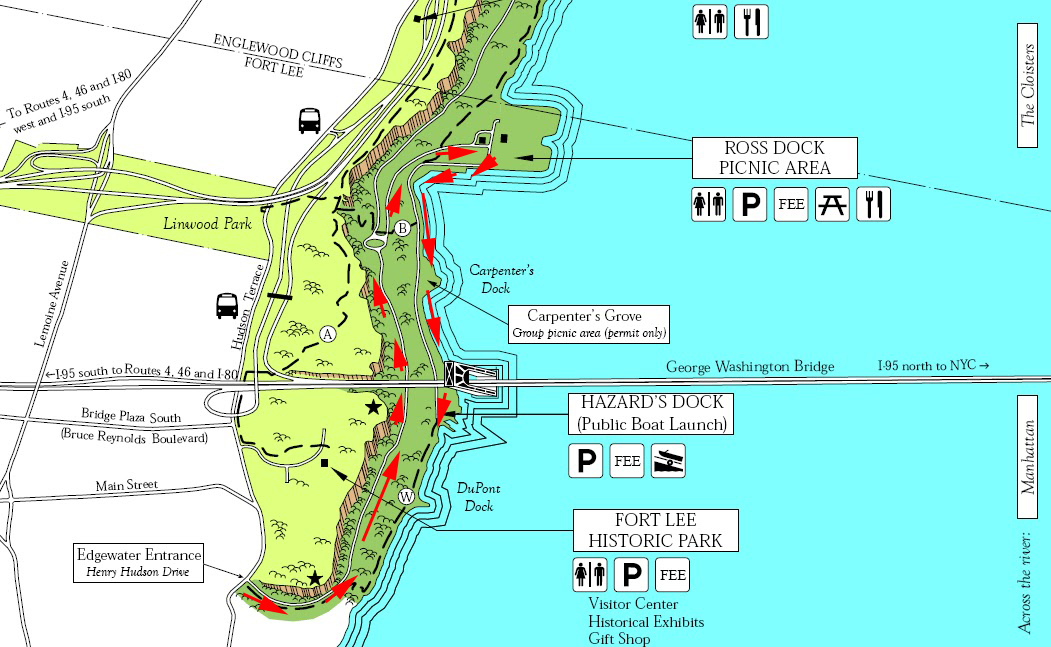
Plus I was there that morning at the Travel Inn! I saw him and bumped into him in the elevator doors at around 8:50 a.m.
That was nearly hours later than when Cottingham said that he set three fires to the mattresses and departed around 5:30 a.m.
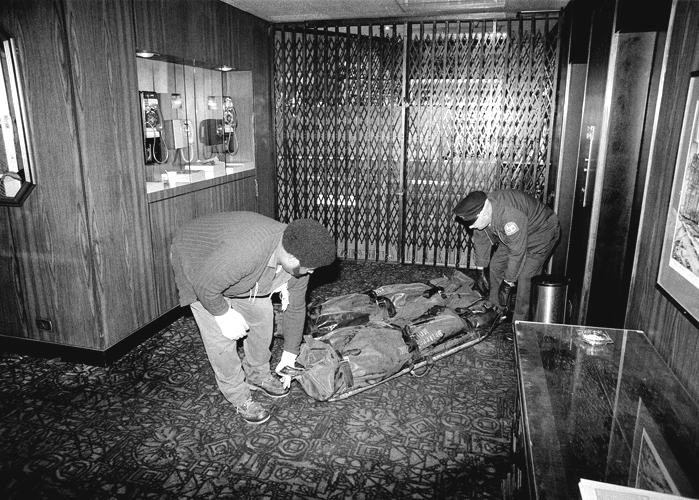
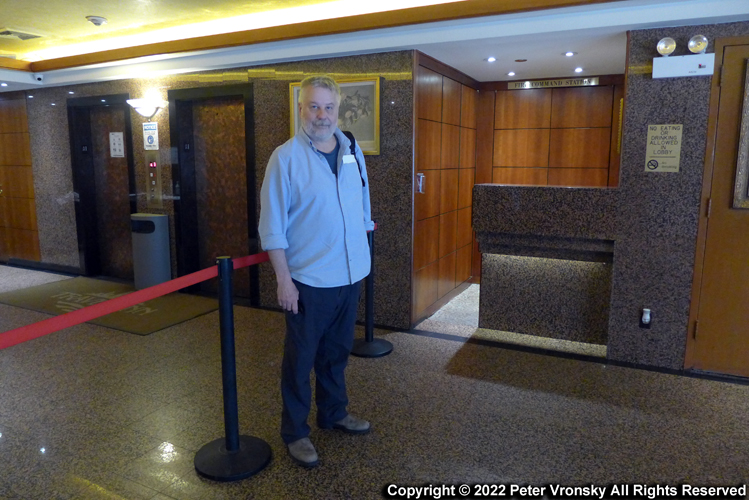
The lobby where I briefly encountered the
Torso Killer on December 2, 1979 and a photo taken of me by Jennifer
42-years later in the same hotel: the Travel Inn on W 42nd Street.
It's implausible that three separate mattress fires burned for hours from 5:30 to 9:00 a.m. without being discovered earlier; and that so little of the mattresses and the victims' bodies were consumed by the flames. Moreover, the FDNY arson investigator, concluded that the fires were set approximately 20-minutes prior to the firefighters arriving at the scene. (Of course, the investigator could be mistaken in his estimate.) Finally, in the NYPD case files, there is a report about one of the hotel housekeepers refusing to talk to police because she was terrified. According to another housekeeper who worked with her, that morning when she knocked to enter the room to clean it, she got no response, and when she tried opening the door, the chain was on it. She was now frightened to talk to police, assuming the murderer had been still in the room.
I was caught up in the smoke and fire alarm and left the hotel by the fire stairs, through its parking garage on the upper floor, down the ramp out into the street as the fire engine was arriving at the hotel. According to FDNY they arrived on site at 9:10 a.m. The fire station was just around the block, on W43rd Street.
I did not see the newspapers until the next day, reporting that there were two headless torso set on fire in the hotel I had been in yesterday. And by then I had completely forgotten the 'jerk off' on the elevator that bumped me with the bag.
The fire was the big event in my memory, and that there were torsos set on fire. That was the story I told my friends over drinks when I returned to Toronto.
And in 1979, the word "serial killer" was not used, nor the idea that a serial killer is somebody who could be your neighbour, or somebody you worked next to in the office, or a guy on an elevator. I never thought of him, the guy on the elevator.
It was only some eighteen months later, when Cottingham went on trial and his picture appeared in the newspapers, that I recognized Cottingham - or more accurately his haircut - and recalled the 'jerk off' on the elevator whose haircut I noted at the time, who bumped me with a soft bag that felt like it had bowling balls in it.
Or was it just some jerk-off with the same haircut, but not Cottingham?
COTTINGHAM ADMITS TO RETURNING TO THE SCENE OF
THE CRIME
All this I had brought up with Cottingham, on several
occasions challenging him on the veracity of his story. I asked him,
what did he do that Sunday after he buried the heads and came home.
His children were not going to school that day. Did he have breakfast
with his three children that morning? And what did he tell his wife about
being away from Thursday night when he checked into the Travel Inn and
returned on Sunday? Not that he necessarily had to tell her
anything, because she had served him with divorce papers in April 1979, on
the grounds of 'abandonment' - he had stopped coming home, was taking
vacations without his family, refusing to have sex with his wife and giving
her insufficient funds for household expenses, since the birth of his third
and last child in October 1976. After three years of that, his wife
finally served him with divorce papers on the Easter weekend in 1979. (It's
a myth that one of the grounds his wife's divorce petition was that he was
frequenting gay and transvestite bars.)
Cottingham responded that it was too late for him to go home, because the sun had already come up and it was daylight. The neighbors would have seen him coming home by then.
Instead he returned
back across the bridge to Manhattan to sleep at his girlfriend Barbara's
apartment near E28th Street and Second Avenue. He said he spent Sunday
with her until it was time for him to go to work at 4:00 p.m. for his night
shift in the computer room at Blue Cross Insurance.
On the way back from burying the heads in Palisades Park, he
said, he passed by the hotel to see if he had "burned the entire place
down." When he drove by the place, he said he saw no fire trucks or police,
and began to wonder if it was already over. He said that he then
stopped and went for breakfast in a diner from which he could watch through
the window what was happening and that he observed through the diner window
the fire engine arriving and the commotion.
He said, maybe, he returned to the lobby to see if anything was going on, and we bumped into each other then. But that does not sound like Cottingham's MO - "returning to the scene of the crime" so soon.
But there was a diner on the south-east corner diagonally across from the Travel Inn up until around 2003 at least. The Kraft. I even snapped a picture of my wife and kids having breakfast there one day in 2003 on a trip to New York before the diner and the building were torn down to make way for a new office building. The view of the Travel Inn was perfect to observe the fire department trucks and police arriving.
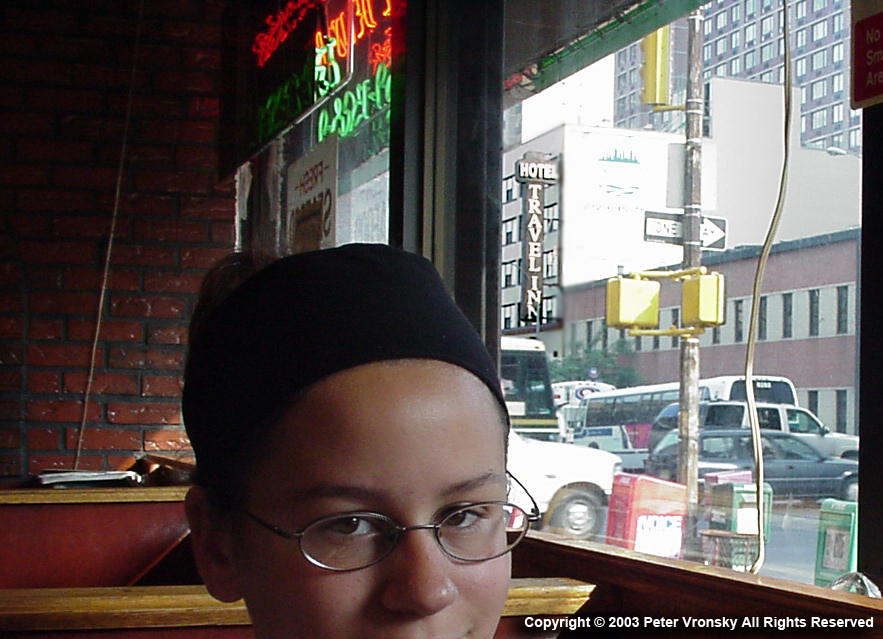
That he would have set the fires at around 8:50 a.m. and perhaps held up the
elevator doors to ensure that the fire was smoking and going and in the
process annoying me as I impatiently waited for an elevator to come down in
the lobby makes sense. And that he would then go for breakfast to
observe the scene from a safe distance makes sense too. That's a big
thing to do, setting a fire in a New York City hotel, something that he
apparently had not done before. Something to watch.
The thing is too, if I was the Torso Killer, that morning, I would have driven ten or twenty blocks away from the Travel Inn, and then stopped to toss the heads deep into a garbage dumpster. End of story. Cops never searched for the heads beyond a few blocks around the Travel Inn, and Cottingham would have known they wouldn't. The chances of those heads if bagged in a garbage bag, easily bought that morning in any grocery-deli-bodega on the way, being found in a dumpster, or even a street garbage bin, were pretty low. But how could Cottingham bring himself to tell Jennifer in 2018that he threw her mother's head in the garbage?
Or he could have thrown the heads into the river from one of the abandoned rotting piers that lined the Hudson River in the 1970s on his way down to Barbara's apartment. The Travel Inn was two blocks away from the Hudson River. He already had thrown a severed head in September into the river at the Christopher Street Pier, that floated and bobbed diagonally in the current to the New Jersey side and was found in Jersey City on the opposite side, floating in water off the First Street Pier in Jersey City, about 1.2 miles south diagonally from Christopher Street Pier in NYC on opposite river bank. The newspapers never reported on the discovery of the head until four days after the Torso Murders.
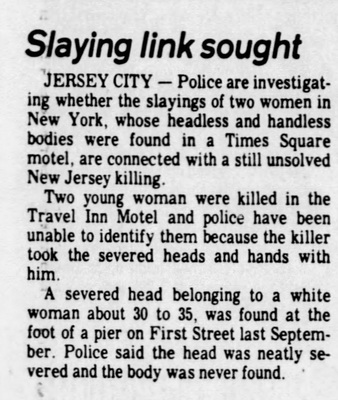
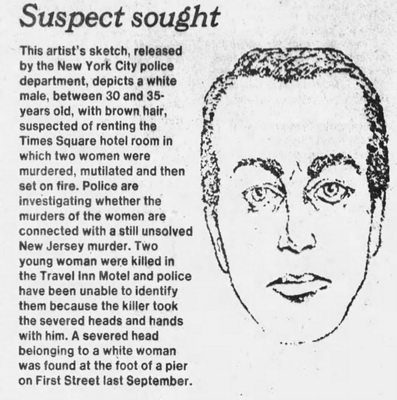
Instead, maybe he invented this elaborate beautiful story how her mother's head had been tenderly buried in a beautiful peaceful location next to a Dogwood tree, never imagining in a million years that a ferret like me - who he still did not know very well - would actually persuade the NYPD to go out and look for the heads and try to dig them up. Even I never imagined I could persuade NYPD in a million years to conduct a search for the heads! It was like a fantasy! Except not a serial killer's one. What I didn't count on was the dedication that Detective Bill Simon had.
I remembered how shocked Cottingham was that I had managed to persuade and mobilize the NYPD to mount this search in January 2019. This was in a period that Cottingham and I were getting to know each other still. But I wondered, was he now locked into the story he told Nadia back in 2009, and now that sweet story he told Jennifer, and he couldn't back out of it without losing face, without having to confess he sent Jennifer and I on a wild goose chase. I politely brought this possibility up with him a several times since the first search, giving him a graceful out from his 2018 story but he continues to steadfastly insist that the heads are there where he said they are, and I just as steadfastly continue to believe him with a 50/50 possibility that he is telling the truth and the effort should be made in the chance of identifying "Torso Jane Doe."
Either way, whether Cottingham is telling the truth or spinning a tale, I am bound for despair, disappointment and embarrassment.
If we find the heads when and where he says he buried them that Sunday morning, then it means for the last forty five years since 1979 I have been delusional, imaging that I got bumped by him as he was fleeing the scene and I have written four books on serial killers inspired by something that I imagined happened but did not. If we don't find the heads then that is a terrible disappointment in that we will never be able to reconstruct "Torso Jane Doe's" facial features and unless I can persuade the current tight-fisted regime at NYPD to allocate the funds for an exhumation to pinpoint her headless remains and collect her DNA, there is no hope of identifying the teenage girl. And even if we don't find the heads, unless Cottingham admits to fabricating that story, we will never know for sure, whether we simply failed, or animals had gotten to them, or the shifting of the soil perhaps pushed them into the river eventually.
I will be left with a choice, whether to believe Cottingham or trust my own memory and the timing of the fire departments arrive.
It's a lose/lose scenario for me, no matter what. That's what you get for talking with a serial killer.
Next Part 1-C: Partnering with Jennifer & Mapping the Torso Serial Killer's Mind and Murder Victims